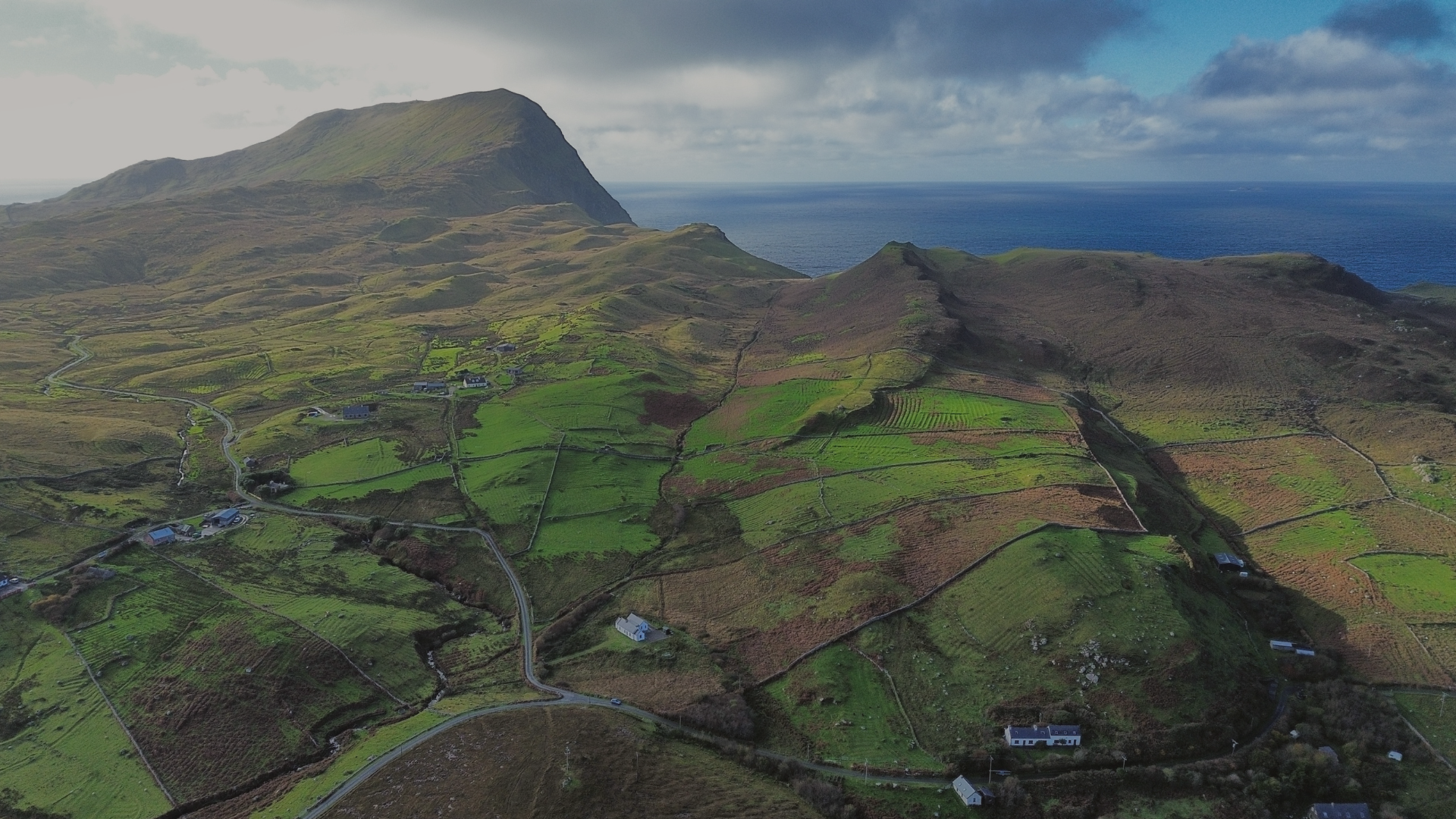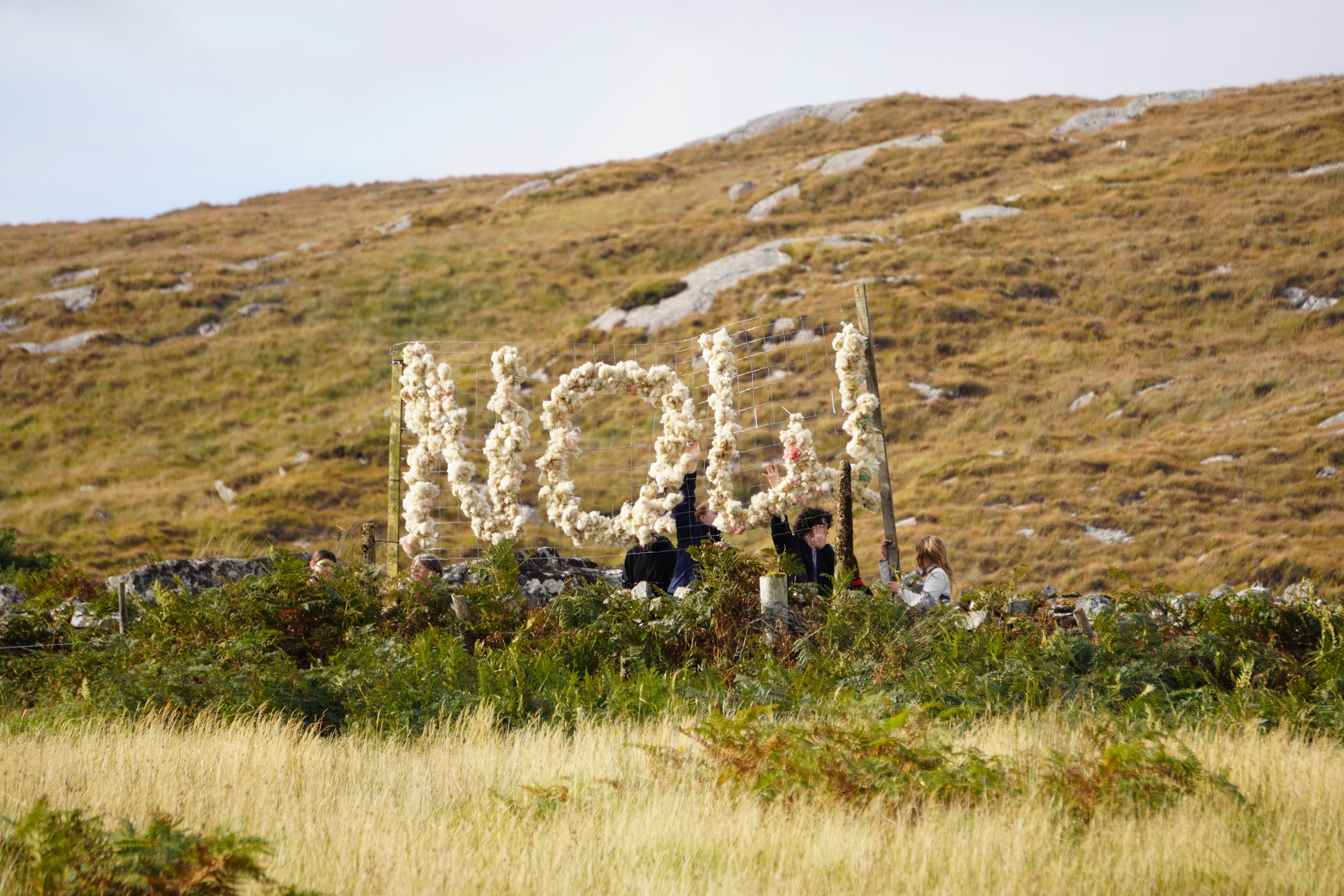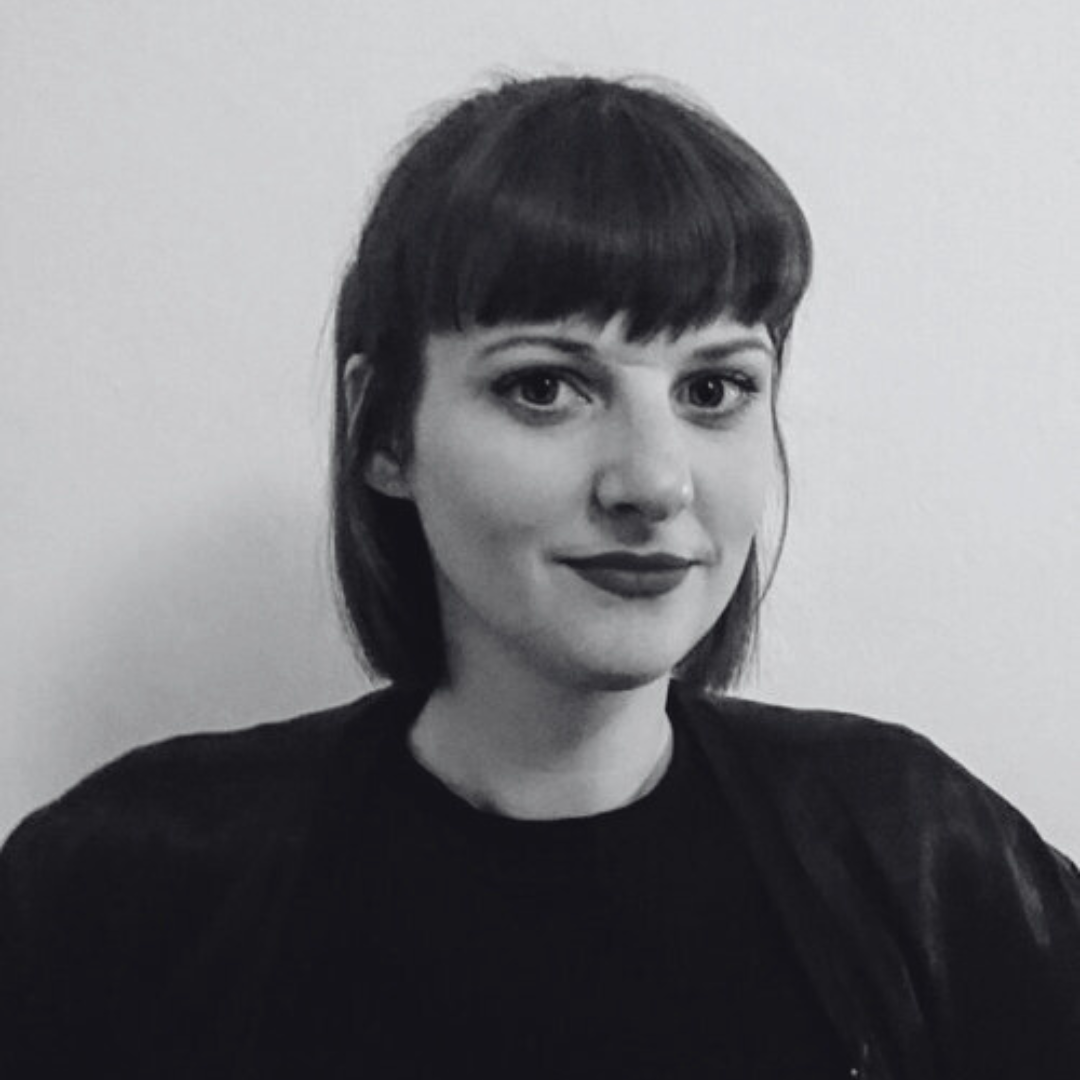
Dinnseanchas - Envisioning the Uplands
Many of Ireland’s coastal upland communities are suffering depopulation, reduced farm incomes and the loss of the Irish language. At the same time, many iconic species and habitats are also in decline. The changing climate is causing wetter and more extreme weather. What does the future hold? Can Dinnseanchas - lore and knowledge of place - help us to navigate this future?
In modern Irish, dinnseanchas means "topography"; the arrangement of features in a landscape. However, the word has an older meaning that describes the lore of a place. It is associated with accounts of the place names, traditions, events and characters of particular areas.
Hometree’s Dinnseanchas Project incorporates both of these aspects while taking a forward-looking approach in exploring the communities, landscapes, habitats, and economies of Ireland’s Atlantic uplands. Lead by a team of artists, ecologists, and communicators, Dinnseanchas aims to support upland communities in understanding the radical role they could play in mitigating the impacts of climate change, the biodiversity crisis, and socio-economic issues such as depopulation.
Dinnseanchas, which is a recipient of Creative Ireland’s Creative Climate Action funding, is supporting immersive residencies for artists within various communities along Ireland’s western seaboard. During these residencies the artists will listen to communities, facilitate conversations and workshops, engage with the difficult themes of biodiversity loss, agricultural policy and practice, and support an envisioning process that elevates the voices of the community themselves. Their creative responses will trace contours of the past, and chart new paths into the future. The artists will be mentored and guided by experienced voices from the worlds of farming, ecology, language, socially engaged artistic practice, and culture.
Dinnseanchas is a sister project to Hometree’s Wild Atlantic Rainforest Project, which is a large-scale landscape restoration project created in response to Ireland’s climate crisis, the neglected uplands and their vanishing oceanic rainforests. Dinnseanchas will provide an arts, heritage and community aspect to the Rainforest project’s ecological work. We hope that it will give a voice to the communities of Ireland’s uplands and to the land itself that will help to inform the work of Hometree and wider policies and conversations as we all face into a future that is demanding us to make collective changes.
Where are we working?
Dinnseanchas is working in six communities on the west coast. The areas were selected because of existing links between the people, the places, the artists, and Hometree. Each of these regions is an upland area characterised by rugged hills and mountains. Most of these areas are experiencing high levels of outward migration and an uncertain future for their communities. Hill sheep farming, mixed farming and tourism are the most common economic activities in these regions with many farmers travelling elsewhere to work off-farm. These communities generally feel a strong link to their landscape, their way of life, their language, and to each other. Our artists are listening to stories, to concerns, exploring the landscape, working alongside people, and thinking creatively about how the dinnseanchas of each area can help to inform pathways to the future within the context of a changing climate, a biodiversity crisis, and current policies.
Read news and updates from the project
Dinnseanchas Community Artists
Zoë Rush
As an interdisciplinary artist dedicated to community-led resilience, Zoë’s practice merges creative expression, environmental immersion, and research methods from the social sciences. Through practices like soundwalks, visual scribing, and co-creation workshops, she facilitates experiences that invite participants to explore their relationship with place and envision sustainable futures.
Zoë supported the Killarney Cup Project to design immersive experiences for over 600 students in the area to support younger generations to explore their natural heritage and develop climate actions that are relevant to their lives.
With Dinnseanchas, she will work with the communities near her home in the uplands of Corca Dhuibhne.
William Bock
William Bock (williambock.com) produces innovative socially focused projects for and about diverse communities and the environments they inhabit. Born in Cork with a diverse cultural family background, his work explores the connections between identity, heritage, ecology and migration. William works with tactile media and makes space for conversation and exchange in his projects.
He has recently engaged with projects with ArtHouse, Jersey Island and the Harvest Festival, Morocco. He is a member of the Wilderness Art Collective and a founding member of award winning artist group Dig Collective.
William is working alongside communities in the Coomhola and Borlin Valleys on the Beara peninsula in West Cork.
Síomha Brock
Independent musician Síomha (pronounced She-vah) is an artist at the forefront of the recent cultural revival of the Irish language, using the language in a context that hasn’t been seen before. Her work also extends beyond music into activism and she carries this into her arts practice, offering free mentorships, creating recycled and second-hand merchandise, and engaging regularly with and fundraising for various charities and social justice organisations.
The beautiful landscape and rugged nature of her native West of Ireland are a huge source of inspiration for this proud Co. Clare native. She is exploring the dinnseanchas of and engaging with the community around her in her new home of Uíbh Ráthach in south Kerry.
Peadar-Tom Mercier
Peadar-Tom is a traditional musician, tutor and event producer from An Cheathrú Rua, Galway. He teaches traditional music through Irish in schools around the Gaeltacht, organizes arts events with the group Gliogar and is the bandleader/composer for the group Trá Pháidín. He is focussed on a long-term development of the cultural landscape through the Irish language, be it through sharing the traditional arts with younger generations or nurturing a community of artists and patrons as stepping stones for the wider ecosystem.
Peadar-Tom is exploring psychogeography, community development, folklore, education and the development of future scenarios within the communities around Mám in county Galway.
Róisín de Buitléar
Róisín is a visual artist, educator and curator. She has worked with glass since 1982, drawing inspiration from her cultural heritage. She has site-specific installations in public buildings throughout Ireland. She often works in collaboration with communities and marginalised people to create projects that bring awareness to social and cultural issues. Her recent work concentrates on climate action and building awareness around social responsibility for civic action.
Within Dinnseanchas, Róisín is working through Irish as much as possible and engaging with communities around Gartan, Glenveigh and Letterkenny to explore the future of these sheep farming regions.
Patrick Mulvihill
Patrick Mulvihill co-founded Amicitia in 2015. This social enterprise nurtures place-based economic, social, and cultural strategies to promote a just transition. These projects include a community cafe, sustainable energy community and adult education programs. Patrick weaves together sound engineering and systems design within community-engaged projects to create immersive, multisensory experiences that resonate deeply with participants. His work aims to amplify the voice of the community and transform spaces into interactive platforms for storytelling, environmental awareness, and cultural exchange.
Patrick is collaborating with Heather to listen to, learn from, and reimagine the communities around Lyreacrompane in Co. Kerry.
Heather Griffin
Heather Griffin traverses the boundaries of art, design and futures, creating new narratives for our transitional times. Within this space she presents alternative visions of the world through speculation, world building, play, and experiential learning. She analyses and utilises mythologies, social phenomena, and the rhythms of everyday life to critique the contradictions of our contemporary capitalist realities. She adopts a pluralistic, iterative approach and prioritises interdisciplinary collaborations to engage communities, conduct deep research, and embrace complex systems.
Heather is working with Patrick and the communities around Lyreacrompane in Co. Kerry.
Dinnseanchas Consultants and Artists in Residence
Grace Wells
Grace Wells is participating in the Dinnseanchas project as writer-in-residence. Grace is an award-winning eco-poet and environmental writer, who also creates eco-poetry film. Nature, spirit-of-place and environmental concern have been the main themes of her writing ever since the publication of her first book, the children’s novel ‘Gyrfalcon’. Wells has published three books of poetry, most recently in 2022, ’The Church of the Love of the World’. Grace has volunteered with Hometree for many years, and also supported the charity with a number of writing projects, including ‘Under Summer Pastures’.
Within Dinnseanchas, Grace will write about the role of language in the ecological crisis. She will explore the language we use to speak of our ecological challenges, and the ways we feel free or restricted in speaking of our love for the earth, or how we hold nature as sacred. Her work reflects on the impacts of eco-shame on our capacity to reach our deepest Earth-centred values and increase the speed of behavioural change. She has worked in eco-arts for more than twenty years and understands the challenges artists can face, and the benefits of additional support with community projects.
Jennifer Ahern
Jennifer is an artist, environmental anthropologist and researcher, currently based in the Environmental Research Institute in University College Cork. Drawing on multiple frameworks, such as the narrative lens, systems thinking, regenerative design, and climate justice, her work explores the intersection between humans and the more-than-human world, the relationship between nature and culture, and how values shape our landscapes.
Using an engaged methodology and transdisciplinary approach, Jennifer is currently conducting a PhD research study examining the nature of transformative change in communities addressing sustainability challenges. With a particular focus on how global systems and narratives manifest at the local level, and the power of bottom up community-led action as a pathway to transformation. As part of this work she is collaborating with Hometree on Dinnseanchas and will be working alongside the artists throughout the project.
Jennifer holds a MA (hons) in Anthropology, specialising environmental anthropology, from UCC and a B.A. in Fine Art from the Crawford College of Art and Design.
Dr David Teevan
David Teevan has worked for over thirty years as a creative producer, festival maker, researcher and consultant. Since 2022, David has been working freelance as an arts consultant, supporting festivals and community engaged art organisations to develop strategic plans and build operational sustainability. Current projects include managing the Naturally Wild Festival consortium’s development of a fit-for-purpose Carbon Calculator suitable for a multi-venue urban festival, and assisting a number of Kerry festivals develop EDI policies and deliver new programmatic features that broaden their public engagement to reach and represent the diversity of the communities living in their area.
In 2020, David was awarded a PhD from the School of Art History and Cultural Policy at UCD for his study of the challenges artists face when co-creating and co-authoring art with communities of place or interest. He is a co-founder of the Irish Arts Festival Archive, which is housed in the UCD Library as part of the Cultural Heritage Collection. Over the last number of years, David has been a regular lecturer on Arts Management Masters courses at University of Galway, University of Limerick, University College Dublin and Hochschule Heilbronn.
Dinnseanchas is lead at Hometree by Development lead, Ray Ó Foghlú, and Project Manager, Lucy Taylor, with the support of the wider administrative, communications, and management teams.

























